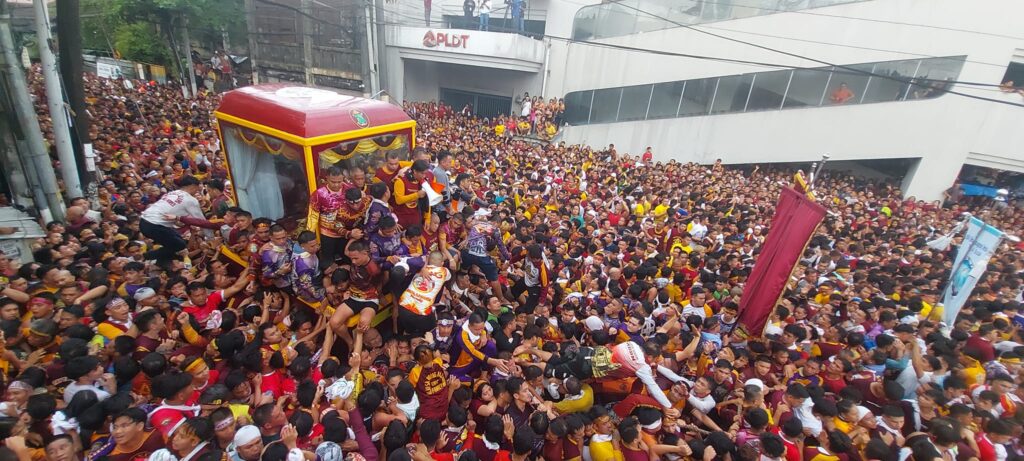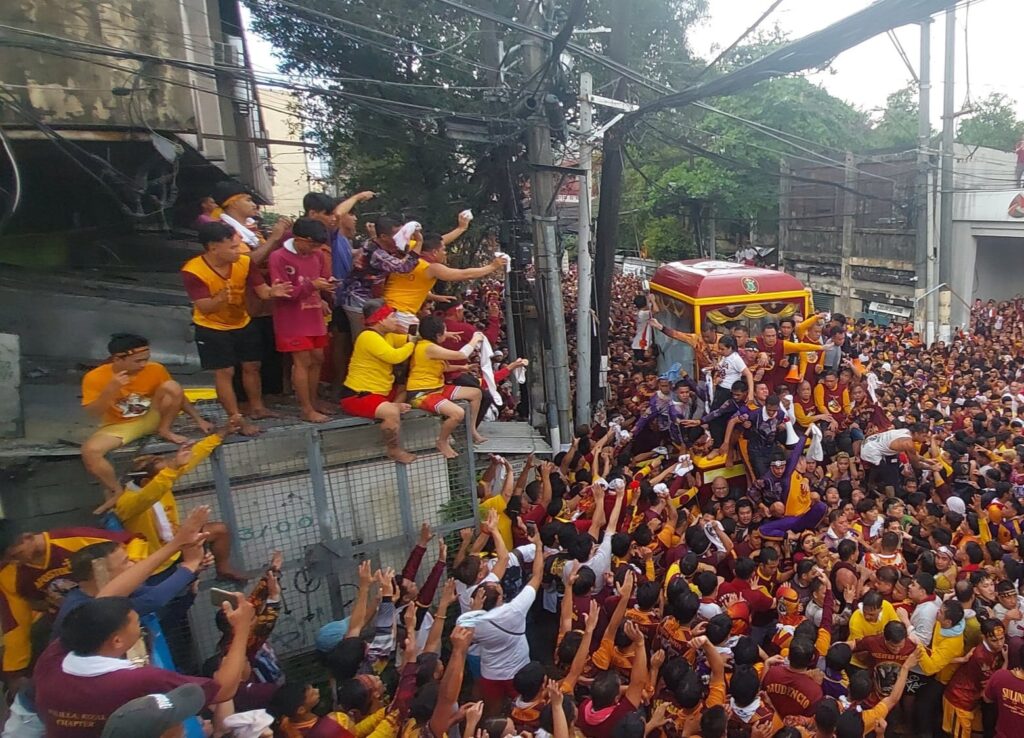Walking barefoot during Traslacion
Walking barefooted during the Traslacion is a symbolic gesture that emulates Christ’s suffering as he was carrying his cross to Golgotha.
I was able to personally witness for the first time the procession of the Black Nazarene in Manila called “Traslacion,” which in Spanish means “passage” or “moving something from one place to another”.
The Traslación is held every 9th of January as a re-enactment of the “solemn transfer” from Intramuros to Quiapo Church of the Black Nazarene’s replica, which was brought to the Philippines in 1606. It depicts Jesus en route to his crucifixion.
In 1608, the icon was enshrined at the Recollect church of San Nicolás de Tolentino in the walled city of Intramuros. It was moved to the Saint John the Baptist Church (now known as the Quiapo Church) on January 9, 1787.
This year’s traslacion took almost 15 hours after it started at around 5:00 a.m. from Quirino Grandstand. The procession then passed through the narrow streets of Manila’s San Miguel and Quiapo districts before ending at the Minor Basilica and National Shrine of Jesus Nazareno at 7:45 p.m.
A feature of traslacion is the “Dungaw” or “La Mirata” ritual, which is the historic practice of the San Sebastian and Quiapo churches, the Black Nazarene meets the image of Nuestra Señora del Carmen de San Sebastian.
The 2012 Traslación was the longest in recorded history as it ended 22 hours after leaving the Quirino Grandstand. The Black Nazarene arrived at Plaza Miranda around 5:15 o’clock the next morning.
From 2021 to 2023, the traditional Traslación was cancelled due to the COVID-19 pandemic.
Filipino Catholics are known for having sincere, enormous, and extreme expressions of piety considering that the country has the third-largest Catholic population in the world.
The fervent devotion and faith shown by devotees became a prime manifestation of the fusion of Catholic and secular beliefs and practices of Filipinos.
Large crowds donned in predominantly maroon and yellow shirts waved white towels in the air as they forcefully gathered towards the carriage called “andas” as it crawled through the generally narrow roads of the city.
Many devotees join the processions as part of their “panata” (vow) which is usually carried out as a plea to God or as thanksgiving for healing, blessing, or granting of/granted wish.
The statue is believed to have magical and healing powers that can heal illnesses and grant miracles.
Devotees believe that walking barefoot, wiping the image with the towels, holding and pulling the ropes of the andas, and even climbing the carriage, will get them closer to achieving their prayers.
Devotees vie to touch the Kanang Balikat, or the rope to the side of the image’s right shoulder due to the belief that it possesses great sanctity as holding it is closer to imitating the image bearing the Cross.
Devotees use physical force to aggressively touch the image mounted on the carriage andas.
I remember my father attending the annual Traslacion until he stopped when he was diagnosed with diabetes. It will be dangerous for him to walk barefooted like the other devotees due to the possibility of wounds.
Although I just wanted to be a bystander watching the traslacion, I was accidentally pushed at a certain point to the “agos”, which translates to “waves” or the sea of devotees where one is forced to go with the direction of the crowd.
Historian Xiao Chua explained in an interview that Filipinos are “visual” people when it comes to faith and history who like to tell stories by acting them out in the form of mass gatherings like processions.
He said that it is a symbolic gesture that emulates Christ’s suffering while carrying the cross to Golgotha.
Xiao noted that the “simulated choreographed craze” and the hardships of the devotees — being pushed around during the procession — “is like showing God that one is making sacrifices, atoning for his sins and making him reflect. ”
I sometimes jokingly link the traslacion with the University Athletic Association of the Philippines (UAAP) as the color maroon is associated to the traslacion and the University of the Philippines (UP). In fact, I wore a UP maroon shirt and a UPFight headband during the traslacion.
The Catholic Bishops Conference of the Philippines (CBCP) approved July last year the proposal to make January 9 a nationwide religious event.
The Peñafrancia Festival in Naga City has two Traslacions every September for the transfer, from the Basilica to Naga Cathedral and back, of the Divino Rostro (Divine Face of Jesus) and “Ina” or Our Lady of Peñafrancia, patroness of the Bicol region.
Penafrancia , which has been described as the biggest Marian event in Asia, is a celebration of two feasts—Divino Rostro on the second Friday of September and Our Lady of Peñafrancia (Ina) on the following week.
(Peyups is the moniker of University of the Philippines. Atty. Dennis R. Gorecho heads the seafarers’ division of the Sapalo Velez Bundang Bulilan law offices. For comments, e-mail [email protected], or call 0917-5025808 or 0908-8665786.)
ALSO READ
Nazareno 2024: Traslacion ends after 15 hours
Honoring Rizal’s literature and social activism through movies, plays and TV series
IKOT jeep phaseout highlighted in UP Lantern Parade
To teach law in the grand manner
Disclaimer: The comments uploaded on this site do not necessarily represent or reflect the views of management and owner of Cebudailynews. We reserve the right to exclude comments that we deem to be inconsistent with our editorial standards.


